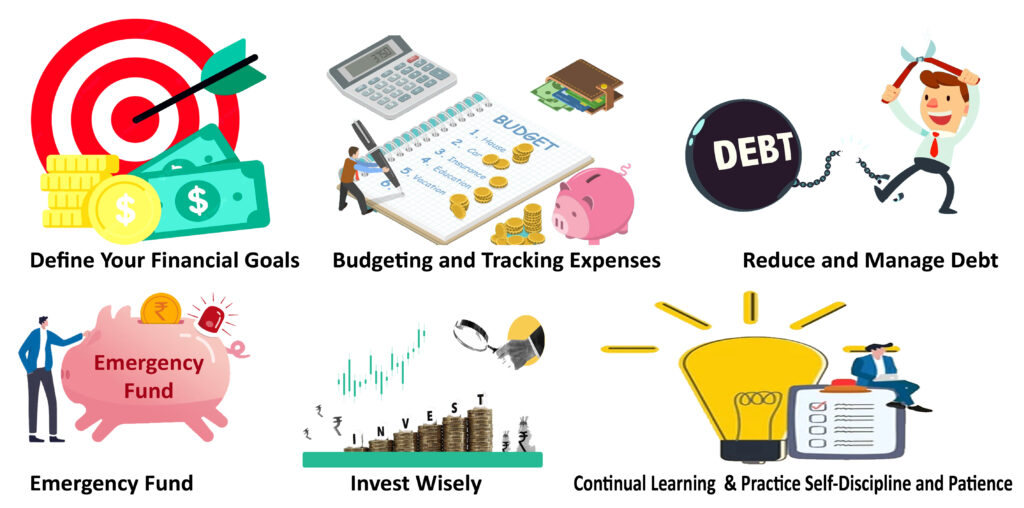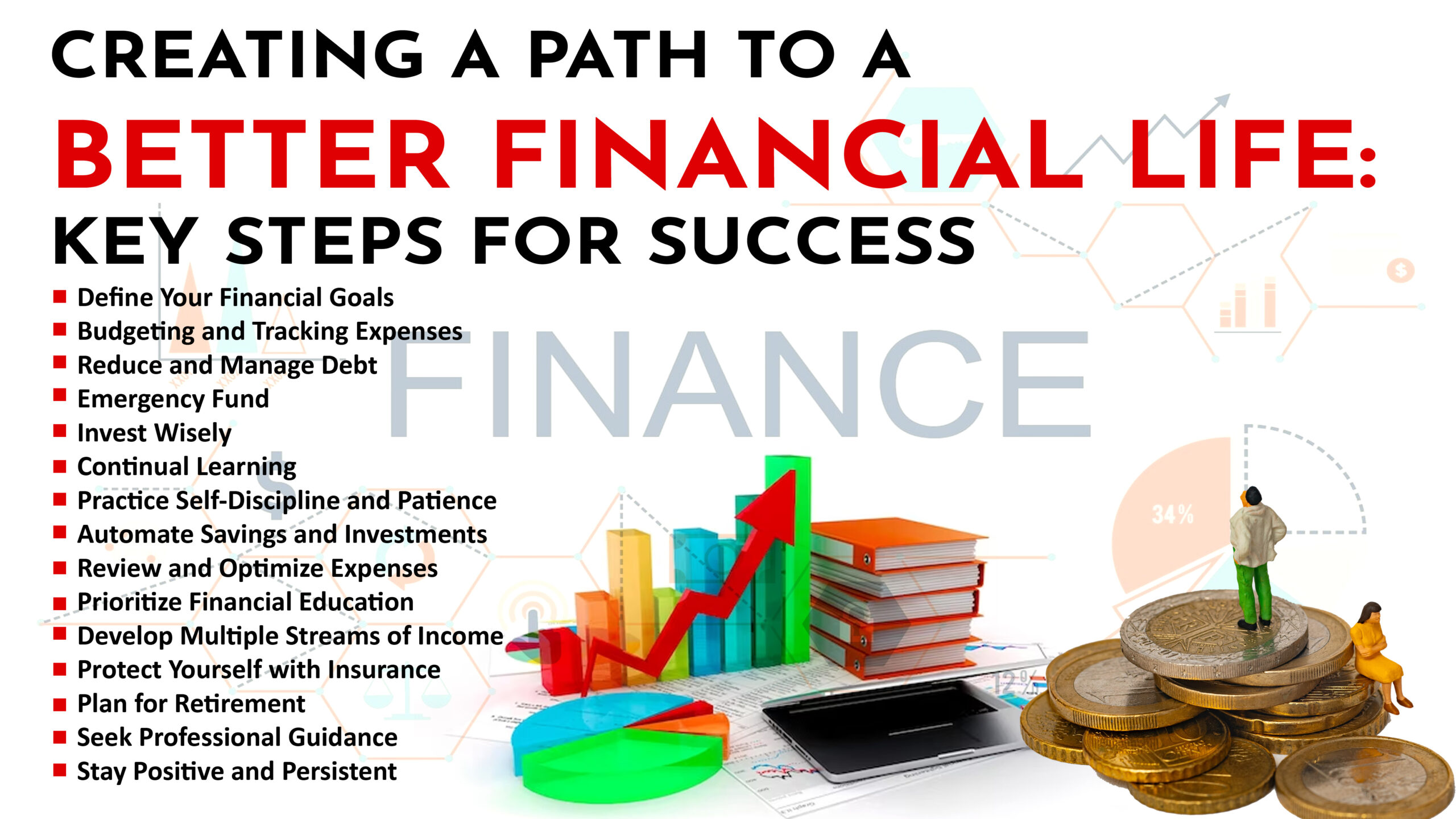Introduction: In today’s fast-paced and unpredictable world, achieving financial stability and security has become increasingly important. A better financial life not only provides a sense of freedom and peace of mind but also empowers us to pursue our dreams and goals. While it may seem daunting, improving your financial situation is within your reach. By implementing key strategies and adopting positive financial habits, you can create a solid foundation for a better financial future. In this blog post, we will explore practical steps to help you pave the way towards a brighter financial life. Creating a Path to a Better Financial Life.

- Define Your Financial Goals: The first step in creating a better financial life is to clearly define your goals. Take the time to reflect on what you want to achieve financially, whether it’s saving for a down payment on a house, paying off debt, or building a retirement fund. Setting specific, measurable, attainable, relevant, and time-bound (SMART) goals will give you a clear direction and motivation to work towards them.
- Budgeting and Tracking Expenses: Creating and sticking to a budget is a fundamental aspect of financial success. Start by tracking your income and expenses for a few months to get a clear understanding of where your money is going. Categorize your expenses and identify areas where you can cut back or make adjustments. Allocate a portion of your income towards savings and investments. Regularly reviewing and adjusting your budget will help you stay on track and make necessary adjustments as your financial situation evolves.
- Reduce and Manage Debt: Debt can weigh heavily on your financial well-being. Prioritize paying off high-interest debts, such as credit card balances or personal loans, as quickly as possible. Consider strategies like the debt snowball or debt avalanche method to systematically eliminate debt. Create a repayment plan that aligns with your budget and stick to it diligently. Avoid incurring unnecessary new debts and focus on living within your means.
- Emergency Fund: Building an emergency fund is a crucial component of financial stability. Aim to save three to six months’ worth of living expenses to protect yourself from unexpected events like job loss, medical emergencies, or car repairs. Set up an automatic transfer from your paycheck or bank account to ensure consistent contributions to your emergency fund. Having this financial buffer will give you peace of mind and prevent you from falling into debt during challenging times.
- Invest Wisely: While saving money is essential, investing allows your money to grow and work for you in the long run. Educate yourself about different investment options, such as stocks, bonds, mutual funds, or real estate. Consider seeking professional advice from a financial advisor who can help you create an investment strategy aligned with your goals and risk tolerance. Remember, investing is a long-term game, and diversifying your portfolio can help mitigate risks.
- Continual Learning: Financial literacy plays a crucial role in building a better financial life. Take the initiative to educate yourself about personal finance topics through books, podcasts, or online resources. Expand your knowledge about budgeting, investing, taxes, and retirement planning. By continually learning and staying informed, you can make well-informed financial decisions and adapt to changing circumstances effectively.
- Practice Self-Discipline and Patience: Achieving financial success requires discipline and patience. Be mindful of impulsive spending habits and strive to differentiate between needs and wants. Avoid unnecessary expenses and make conscious choices aligned with your financial goals. Cultivate patience when it comes to investment returns or paying off debt. Rome wasn’t built in a day, and building a solid financial foundation takes time.
Creating a better financial life is a journey that requires commitment, discipline, and a proactive mindset. By setting clear goals, budgeting effectively, managing debt, building an emergency fund, investing wisely,
Creating a Path to a Better Financial Life
Certainly! Here are a few more key steps to create a better financial life:

- Automate Savings and Investments: Make saving and investing a priority by automating these processes. Set up automatic transfers from your paycheck or bank account to your savings and investment accounts. This way, you won’t have to rely on willpower alone to save or invest, and you’ll consistently build wealth over time.
- Review and Optimize Expenses: Regularly review your recurring expenses, such as subscriptions, utilities, and insurance policies. Look for ways to optimize these costs by comparing different providers, negotiating better rates, or eliminating unnecessary services. Even small savings in multiple areas can add up significantly over time.
- Prioritize Financial Education: Continually educate yourself about personal finance topics to enhance your financial decision-making abilities. Attend workshops, webinars, or seminars, and read reputable financial books or articles. Stay informed about current trends, tax laws, and investment strategies to make informed choices for your financial future.
- Develop Multiple Streams of Income: Relying solely on a single income source can be risky. Explore opportunities to create additional streams of income, such as freelancing, starting a side business, or investing in income-generating assets. Diversifying your income can provide stability and accelerate your journey towards financial independence.
- Protect Yourself with Insurance: Insurance is an essential aspect of financial planning. Evaluate your insurance coverage, including health, life, disability, and property insurance. Ensure that you have adequate coverage to protect yourself and your loved ones from unforeseen circumstances. Review and update your policies regularly to reflect any changes in your life or financial situation.
- Plan for Retirement: Regardless of your age, it’s crucial to start planning for retirement early. Contribute to retirement accounts like a 401(k) or an Individual Retirement Account (IRA). Take advantage of employer matching contributions if available. Calculate your retirement needs and regularly reassess your progress towards your retirement goals. The power of compounding interest means that the earlier you start, the better off you’ll be in the long run.
- Seek Professional Guidance: If you’re unsure about financial matters or need personalized advice, consider consulting a qualified financial advisor. They can provide tailored guidance, help you create a comprehensive financial plan, and assist with investment strategies. Choose an advisor with the necessary credentials and ensure they have a fiduciary duty to act in your best interest.
- Stay Positive and Persistent: Improving your financial life requires dedication and perseverance. There may be setbacks and unexpected challenges along the way, but maintaining a positive mindset and staying focused on your goals will help you overcome obstacles. Celebrate small wins and stay motivated by envisioning the financial future you desire.
Remember, creating a better financial life is a continuous process. It requires a combination of discipline, knowledge, and adaptability. By implementing these key steps and making conscious choices aligned with your goals, you can transform your financial situation and build a more secure and prosperous future.



